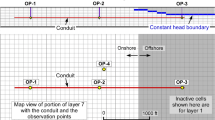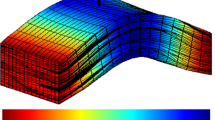Abstract
Most karstic aquifer media may be characterized as the triple-void media with highly-varied hydraulic properties, including matrix pore, fissure and conduit, in which liner flow may co-exist with non-linear flow. In this paper, an attempt is made to couple linear flow with non-linear flow in a single unified flow governing equations by introducing the concept of equivalent hydraulic conductivity (EHC) and deriving a general Darcy’s law for various flow. The expression of EHC in the karst conduit and fissure are also derived. The procedures of numerical implementation are demonstrated via an ideal model and a case study of karst aquifer system in the Beishan Ore Formation area, Guangxi Autonomous Region, China.













Similar content being viewed by others
References
Atkinson TC (1977) Diffuse flow and conduit flow in limestone terrain in the Mendip Hills, Somerset, Great Britain. J Hydrol 35:93–110
Barenblatt GE, Zheltov IP, Kochina IN (1960) Basic concepts in the theory of seepage of homegeneous liquids in fissured rocks. J Appl Math Mech (USSR) 24:1286–1303
Bear J (1972) Dynamics of fluids in porous media. Elsevier, New York
Chen CX (1966) Groundwater hydaulics (in Chinese). Beijing Geology College, Beijing
Chen CX (1995) Groundwater flow model and simulation method in triple karst tube-fissure-pore (in Chinese with English abstract). Earth Sci 20(4):361–366
Chen CX, Jiao JJ (1999) Numerical simulation of pumping tests in multiplayer wells with non-Darcian flow in wellbore. Ground Water 37(3):465–474
Chen CX, Wan JW, Zhan HB (2003) Theoretical and experimental studies of coupled seepage-pipe flow to a horizontal well. J Hydrol 281:159–171
Chen CX, Wu L, Lin M (1992) Theory and application of model couping seepage and pipe flow for unsteady multilayer pumping tests. Science and Technical Report. No. 88172K051 (In Chinese). Geology and Mineral Resources Bureau, Guangxi autonomous region, China
Cornation F, Perrochet P (2002) Analytical 1D dual-porosity equivalent solutions to 3D discrete single-continuum models. Application to Karstic spring hydrograph modelling. J Hydrol 262:165–176
Cui GZ, Zhu YF (1988) Hybrid simulation for karst water systems: exemplified by Beishan karst water system (in Chinese with English abstract). Carsolog Sina 7(3):15–19
Dreiss SJ (1982) Linear Kemels for karst aquifers. Water Resour Res 18(4):865–876
Eisenlohr L, Kiraly L, Bouzelboudjen M, Rossier Y (1997) Numerical simulation as a tool for checking the interpretation of karst spring hydrographs. J Hydrol 193:306–315
Halihan T, Wicks CM (1998) Modeling of storm responses in conduit flow aquifer with reservoirs. J Hydrol 208:82–91
Howard AD, Groves CG (1995) Earlyde-velopmentofkarstsystems: 2. turbulent flow. Water Resour Res 31(1):19–26
Kaufmann G (2003) A model comparison of karst aquifer evolution for different matrix-flow formulations. J Hydrol 283:281–289
Lan Z, Chen M, Chen C (1977) Application of system analysis approach in the response of Le Long Dong karst spring (in Chinese). J Hydrogeol Technol Approach 3:22–32
Larocque M, Banton O, Ackerer P, Razack M (1999) Determining karst transmissivities with inverse modeling and an equivalent porous media. Ground Water 37(6):897–903
Liedl R, Sauter M, Huckinghaus D, Clemens T, Teutsch G (2003) Simulation of the development of karst aquifer using a coupled continuum pipe flow model. Water Resour Res 39(3):1057–1067
Lin M, Chen CX (1988) Analytic models of groundwater flows to karst springs. In : Yuan DX (ed) Karst hydrogeology and karst environment protection, Proceedings of the 21st IAH Congress, Wallingford, Oxfordshire, IAHS Spec Publ. No.176 1(2):647–654.
Lomijie GM (1951) Groundwater movement in rock formation (in Russian), National Electric Publishing House, Russia
Mohrlok U, Teutsch G. (1997) Double continuum porous equivalent (DCPE) versus discrete modelling in karst terranes. In: Günay G, Johnson AI (eds) Karst water and environmental impacts. Proceedings 5th international symposium and field seminar on karst waters and environmental impacts, 10–20 September1995, Antalya, Turkey, Balkema, Rotterdam, pp 319–316
Sauter M, Liedl R (2000) Modeling karst aquifer geneisi using a coupled continuum-pipe flow model. In: Klimchouk AB (ed) Speleogenesis-evolution of karst aquifers. Nat. Speleol. Soc., Huntsville, Alabama, pp 212–219
Streeter VL (1961) Handbook of fluid dynamics. McGraw-Hill, New York
Teutsch G (1993) An extended double-porosity concept as a practical modeling approach for a karstified terrain. In: Cultekin G, Johnson AI, Back W (eds) Hydrogeological processes in karst terrains. Proc. Antalya Symposium and Field Seminar, IAHS Spec. Publ. 207, pp 281–292
White WB (1969) Conceptual models for carbonate aquifers. Ground Water 1(1):15–21
White WB (2002) Karst hydrology: recent developments and open questions. Eng Geol 65(2–3):85–105
Wicks CM, Heman JS (1995) The effect of zones of high of porosity and permeability on the configuration of saline-freshwater mixing zone. Ground Water 33(5):733–740
Worthington SRH (2003) A comprehensive strategy for understanding flow in carbon aquifer. Speleog Evol Karst Aquifers 1(1):1–8
Zhang BY, Lerner DN (2000) Modeling of ground water flow to adits. Ground Water 38(1):99–109
Zhu YF, Cui GZ, Qin XQ, Xia ZY (1992) The analysis of groundwater flow systems in karst aquifers: approach and application (in Chinese). Guangxi Science and Technology, Nanni, China
Acknowledgement
This research is supported by the National Nature Sciences Foundation of China (NSFC). (Nos. 49872081 and 40202024). The authors thank Prof. Guangzhong Cui (Institute of Karst Geology, P.R. China) and Mr. Xuequan Yuan (The Seventh Geology Institute in Guangxi) for their support in geologica data, as well as Dr. Jiu Jimmy Jiao whose constructive suggestions led to a significant improvement of the manuscript. The authors would like to acknowledge an anonymous member of the editorial board and Professor Xinong Xie who edited the original manuscript and helped us so patiently with the English. Thanks are also given to Ms. Ni Jia and Ms. Yafei Ge for their help with the English.
Author information
Authors and Affiliations
Corresponding author
Rights and permissions
About this article
Cite this article
Cheng, J.M., Chen, C.X. An integrated linear/non-linear flow model for the conduit-fissure-pore media in the karst triple void aquifer system. Env Geol 47, 163–174 (2005). https://doi.org/10.1007/s00254-004-1128-7
Received:
Accepted:
Published:
Issue Date:
DOI: https://doi.org/10.1007/s00254-004-1128-7




